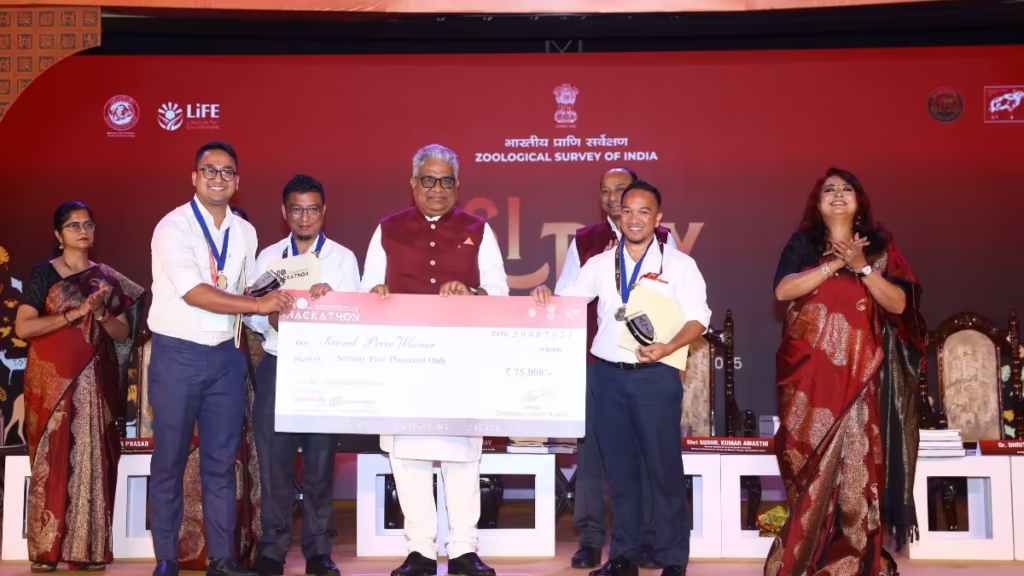Shillong’s St. Anthony’s College has made Meghalaya proud by clinching the second prize at the national-level 110 Hours Hackathon, organised by the Zoological Survey of India (ZSI). Held to mark 110 years of the ZSI’s founding, the event drew talent from across India.
This year’s hackathon theme, “Biodiversity and Climate Change,” challenged participants to develop real-world solutions that bridge conservation, science, and innovation.
A Win Beyond the Trophy
The team from St. Anthony’s College, Shillong, stood out for their project focusing on Meghalaya’s cave biodiversity. These caves, which are among the longest and deepest in India, remain one of the most fragile and least-explored ecosystems in the country.
Their win wasn’t just a technological triumph—it was a call for urgent conservation and sustainable cave tourism.
Innovative Cave Conservation Project
The team’s idea involved an AI-powered monitoring and mapping system designed to study and protect subterranean biodiversity. They proposed a model that uses:
- Sensor-based tracking of temperature, humidity, and air quality
- Biodiversity indexing tools to monitor insect and microbial life
- Community involvement to prevent illegal activities and pollution
According to the students, their idea stemmed from field visits and biodiversity research already being conducted in collaboration with local experts.
Team Speaks About the Motivation
“We wanted our project to make sense for the region we come from. Meghalaya is famous for its caves, yet most of them are under threat. Our solution is rooted in both technology and indigenous knowledge,” said a member of the team during the presentation.
The project also emphasized the importance of climate resilience, considering how rising temperatures and extreme rainfall are affecting the cave micro-ecosystems.
Recognition from the Scientific Community
Officials from the Zoological Survey of India applauded the student-led initiative for blending science and sustainability. Judges praised the project for being “technologically feasible and locally relevant.”
Dr. Manoj Kumar, Senior Scientist at ZSI, said, “St. Anthony’s Shillong hackathon win demonstrates the power of youth-led innovation in regional conservation. Their model can be adapted for cave systems in other northeastern states.”
Growing Interest in Cave Ecosystems
Meghalaya is home to over 1,600 documented caves, many of which are under-researched. These caves host rare life forms, some yet to be scientifically classified.
Recent studies have shown the presence of unique bacteria, algae, and arthropods in these dark ecosystems. However, increased human interference, plastic dumping, and unregulated tourism are posing risks.
The win by the Shillong-based team may trigger more attention to these underground treasures.
Students Hope for Policy-Level Engagement
The team is now looking to collaborate with the Meghalaya Biodiversity Board and cave research groups for on-ground implementation. “We want this idea to reach the government. Even if it starts as a pilot in one cave, it could lead to major reforms in cave protection,” a team member said.
They plan to share their project with stakeholders like the Meghalaya Cave Research Association (MCRA) and local tourism departments.
Zoological Survey of India – Official Website
Meghalaya Cave Research Association
A Model for Youth-Driven Conservation
This victory underscores a larger shift in environmental education. Students are no longer just participants; they are becoming innovators and advocates.
The St. Anthony’s Shillong hackathon win is a sign that climate action can begin with a classroom project—and end with real-world impact.
Call to Action:
Support student innovation in biodiversity. Share this story to raise awareness about Meghalaya’s caves and the urgent need to protect them.


